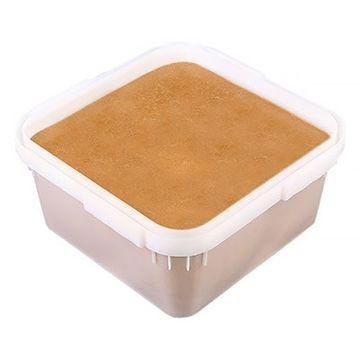Honey with licorice

+7 (961) 993-26-19
- Cup container 15, 33 kilos
- Plastic buckets 1.5, 3, 4.5 kilos
Ingredients: natural honey, licorice root extract.
Plant extracts are obtained by low-temperature technologies, allowing to fully extract and preserve the biologically active substances of plants. The product is made on the basis of high-quality Altai honey. The combination of extracts with natural honey doubles the strength and improves the availability of biologically active substances for the body, which allows to achieve the maximum healing effect.
Licorice (licorice) is a medicinal plant, its root is most often used in medicine.
Plant extracts are obtained by low-temperature technologies, allowing to fully extract and preserve the biologically active substances of plants. The product is made on the basis of high-quality Altai honey. The combination of extracts with natural honey doubles the strength and improves the availability of biologically active substances for the body, which allows to achieve the maximum healing effect.
The base of the plant contains:
saponins;
sucrose;
glucose;
amino acid;
starch;
proteins and minerals;
vitamins.
Chemical composition:
The roots and rhizomes of licorice contain up to 23% saponin - glycyrrhizin (potassium and calcium salt of glycyrrhizic acid), which gives a sugary-sweet taste, as well as numerous derivatives of glycyrrhizic acid; about 30 flavonoids (liquiquirithin, lucuraside, glabroside, uranoside, quercetin, apigenin, ononin, etc.); mono- and disaccharides (up to 20%), starch (up to 34%), pectins (up to 6%), resins (up to 40%), bitter substances (up to 4%), phenol carboxylic acids (salicylic, synapic, ferulic) and their derivatives (salicylic acid acetate); coumarins (up to 2.6%), tannins (up to 14%), alkaloids, essential oil (up to 0.03%), organic acids - up to 4.6% (tartaric, citric, malic, fumaric). The aerial part contains saponins, tannins, flavonoids, essential oil, sugars, pigments and other substances.
Rhizomes and roots contain: ash - 7.88%; macronutrients (mg / g): K - 14.50, Ca - 11.50, Mn - 2.40, Fe -0.70; trace elements (CBN): Mg - 0.15, Cu - 0.31, Zn - 0.33, Cr - 0.07, Al - 0.53, Ba - 0.42, V - 0.28, Se - 12 , 14, Ni - 0.63, Sr - 1.01, Pb - 0.03. B - 54.80 μg / g. Not found Co, Mo. Cd, Li, Ag, Au, I, Br. Concentrates Fe, Sr, Se.
Honey with licorice enhances the work of all the glands of the body, regulates water-salt metabolism, has choleretic, diuretic, antiseptic, anti-inflammatory, antiviral, expectorant properties. Also has the ability to relieve spasms.
What is the use of licorice:
Therapy of the respiratory system. The plant increases sputum production, which helps to cough up a significant number of bacteria from the bronchi. As a result, it is effectively used in the treatment of prolonged dry cough with pneumonia, tonsillitis, for voice regeneration with inflammation of the larynx.
It can relieve inflammation, increases the healing effect of other drugs, enhancing their therapeutic effect, because of this, licorice is added to many medicinal herbs. The root of the plant helps at high temperatures.
Relieves muscle cramps, normalizes the functioning of the heart and blood vessels, improves well-being with low blood pressure, thyroid diseases.
It improves the functioning of the pancreas, increasing the body's productivity of its insulin, this is one of the methods of diabetes treatment. Glycyrrhizic acid, which is obtained from the plant, is used as a sugar substitute for diabetes.
Antidote. Glycyrrhizin contained in the plant blocks the effects of toxins that have penetrated the human body.
Licorice inhibits the development of cancer cells, because of this it is indispensable in the treatment of cancer, as well as prostate adenoma.
Together with other herbs, it is used to treat gastritis, stomach ulcers, as a laxative.
Effectively used for the treatment of allergies and skin diseases.
In a small dosage, licorice products effectively relieve inflammation in the kidneys and the genitourinary system.
It is used in the treatment of joint diseases.
It relieves depression, perfectly enhances the central nervous system tone, reduces fatigue.
Prevention characteristics:
It is used to prevent gastrointestinal diseases, establish the secretion of gastric juice, get rid of heartburn, improve the digestive system.
Constant consumption in small volumes of licorice rhizome stabilizes blood sugar and sterol levels, prevents chronic disease of arteries, diabetes, improves the functioning of the pancreas and adrenal glands.
It has beneficial effects on hormonal balance, increases resistance to oxygen deficiency, normalizes water and salt balance in the body, relieves pain before menstruation, and stabilizes the cycle.
Effectively used to prevent liver disease.
Increases immunity, assists in the prevention of depression. Chinese medicine puts the rhizome of licorice and ginseng in one row, advising people of retirement age to use it to improve their tone and mood, to increase their lifespan.



























